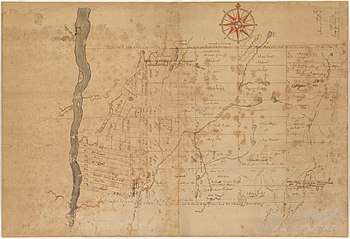Great Nine Partners Patent
The Great Nine Partners Patent, also known as the "Lower Nine Partners Patent," was a land grant in Dutchess County, New York, made on May 27, 1697, by New York governor Benjamin Fletcher. The parcel included about four miles (6 km) along the Hudson River and was eight to ten miles (13 to 16 km) wide, extending from the Hudson River to the Connecticut border.[1]

History
The grant followed the partners' negotiation for approximately 145,000 acres (590 km2) of land with the Wappinger "native Indian proprietors" of central Dutchess County: Perpuwas, Sasaragua, Makerin, Memram, Shawanachko, Shawasquo, Tounis (son of Shawasquo), Acgans, Nimham, Ouracgacguis, Tagahams, Seeck, Cocewyn, Mamany, Arye (Seeck's Son), Wappenas, Tintgeme, Ayawatask, Nonnaparee, and Kindtquaw.[2] Two years later, land bordering the Hudson River comprising approximately 12,500 acres (51 km2) was divided into nine "Water Lotts". No further divisions of the land were made until 1734, when 36 "Second Division Lotts" were laid out, comprising approximately 120,000 acres (490 km2). By 1741, all of the remaining land had been divided. The Nine Partners company began a written record of their activities in 1730, when the land began to be surveyed, and a book containing minutes for approximately 150 meetings from 1730 through 1749 is held by the Dutchess County Historical Society.[2] Some documentation regarding the Little (Second) Nine Partners Tract is available at the Moravian Archives in Bethlehem, Pennsylvania.[3]
Prior to 1734, there had been little settlement in the area, but it proceeded rapidly thereafter. Settlers came to the area up the Hudson, but also from New England. When the legislature divided Dutchess County into precincts in 1737, the Nine Partners Grant was included in the Crum Elbow Precinct. In 1762, the Crum Elbow Precinct was divided into two new precincts, called the Amenia and Charlotte Precincts. In 1786, Charlotte was divided into Clinton and Washington Precincts. Washington Precinct included the towns presently known as Stanford and Washington. Clinton Precinct included present-day Clinton, Hyde Park and Pleasant Valley.[4] In 1788, the precincts were changed into towns, and in 1793 the town of Stanford was separated from the town of Washington. The town of Clinton was divided into Clinton, Hyde Park and Pleasant Valley in 1821.[5]
The Nine Partners
- Col. Caleb Heathcote[6][7]
- Maj. Augustine Graham (son of Speaker James Graham)[8]
- James Emott (or Emmot)
- Lt. Col. Henry Filkins
- David Jamison
- Hendrick Ten Eyck
- John Evertson (also shown as Jan Aarston)
- William Creed
- Jarvis Marshall[9]
Current towns derived from the patent
- Clinton
- Pleasant Valley
- Stanford
- Washington
- Amenia
- Hyde Park (part)
- North East (part)
See also
References
- Genealogy: A Journal of American Ancestry, Volumes 8–10. W.M. Clemens, 1919
- Clifford Buck and William McDermott, "Eighteenth Century Documents of the Nine Partners Patent Dutchess County, New York", Collections of the Dutchess County Historical Society, Vol. X, Gateway Press, 1979.
- See, especially, Miscellaneous documents, mostly on land affairs in Shekomeko, in consultation with the "Second Nine Partners" of Dutchess County, NY, MissInd 113.5, Moravian Archives, Bethlehem, Pennsylvania.
- Huntting, Isaac (1897). History of Little Nine Partners: Of North East Precinct, and Pine Plains, New York, Duchess [!] County. Charles Walsh & Company, printers. p. 33. Retrieved 29 October 2019.
- "The Nine Partners, Dutchess County". www.newyorkroots.org. New York Genealogy Project. Retrieved 29 October 2019.
- "Col. Heathcote's Activities In Early History Here" (Volume XVIII, Number 14). Scarsdale Inquirer. 8 May 1936. Retrieved Feb 23, 2019.
- Reed, Newton (1875). Early History of Amenia. De Lacey & Wiley, Printers. p. 5. Retrieved 29 October 2019.
- Denton, Daniel (2009). A Brief Description of New York. Applewood Books. p. 69. ISBN 9781429022217. Retrieved 30 October 2019.
- Year Book of the Dutchess County Historical Society. The Dutchess County Historical Society. 1928. p. 41. Retrieved 29 October 2019.